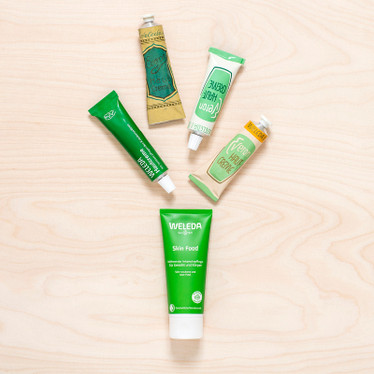When it comes to Mindful Brands, it’s hard to find one with higher ethics than Weleda. The company has been setting standards for certified natural cosmetics and anthroposophic medicines since its foundation in 1921 and we’re proud to say they are our longest-standing Mindful Brand too. In this article Weleda share how they have weighed up the pros and cons of different packaging and how they align with their sustainability goals.
Packaging: a tricky balance
A pioneer and leader in sustainable business practices, Weleda’s packaging has always been a careful balancing act between protecting the precious natural ingredients, overall environmental impact, and consumer usability.
Over the last 100 years Weleda’s packaging has reflected changing graphic design trends, from Art Deco to 60’s Flower Power. Packaging formats have also changed with time. Initially glass and aluminium were the preferred choice for the brand’s delicate natural skincare and remedies. Wax seals and cork stoppers were soon replaced by more reliable hard plastic closures that allowed products to stay fresh longer.
“Our packaging has to do a lot. Weleda is NATRUE certified and uses many natural and sensitive ingredients, such as essential oils and plant oils. And as we refrain from using synthetic preservatives, our packaging has to offer a lot more product protection than is required by conventional products.” says Murat Haner, Head of Packaging Development, Natural Cosmetics at Weleda.
Depending on the product and consumer needs, Weleda’s packaging solutions include glass, aluminium or plastics. Each material has specific advantages and disadvantages.
Glass
Pros:
- Glass bottles can be made from up to 100% recycled glass – and can be recycled again.
- Environmentally friendly material from easily degradable raw material.
Cons:
- Glass is heavier than plastic or aluminium, therefore it has a higher transport carbon footprint.
- Glass may break or shatter, which can be especially hazardous in the bathroom or at the changing table.
Aluminium
Pros:
- Impervious to air, non-reactive.
- Small tube opening.
- Aluminium retains its shape, so there is no suction effect allowing oxygen to enter the tube causing the contents to spoil.
- Particularly good recyclability.
Cons:
- High energy consumption in aluminium production, high environmental impact in bauxite mining.
- Recycled aluminium is not suitable for tube production for quality reasons.
- Tubes can break at the creases.
Wondering why best-seller Skin Food is no longer in aluminium packaging? It is now known that the ecological disadvantages of aluminium are objectively greater, mainly due to the severe ecological destruction caused by mining and the extremely high energy consumption for aluminium production. Sadly, because recycling affects the properties of aluminium, recycled aluminium cannot be used to produce thin, flexible objects such as cosmetic tubes, but it can be used in many other industries. Hence, Weleda has recently reduced the amount of aluminium used in packaging.
Plastic
Pros:
- Good for transport due to low weight.
- Shatterproof.
- Proportion of recycled plastic has continuously increased.
- Easy to handle.
Cons:
- No recycling systems for plastics in many countries.
- Limited availability of high-quality recycled plastics.
- Not all plastic packaging is recyclable.
- Unregulated disposal risks littering the natural environment
“Behind the scenes, our team is constantly rethinking our packaging to make it even more sustainable with less waste and using more recycled materials. We work hard to ensure our packaging is as light and as eco-friendly as possible, selecting the most appropriate materials for individual products so that the quality formulations are protected. Our long-term goal is zero waste.” explains Haner
The plastic packaging Weleda uses is made of PET or PE. Closures are usually made of PP or PE (PET polyethylene terephthalate; PE polyethylene; PP polypropylene). Depending on the composition of the packaging, the proportion of recycled material can be up to 97%.
Lighter plastic packaging means a lower carbon footprint when it comes to transporting products. In 2015 Weleda’s packaging intensity (the ratio of the weight of packaging to the weight of products produced) was reduced by 11%. In 2020, packaging intensity improved by a further 3.8% with the amount of recycled materials used in packaging increasing by 3%.
Weleda’s roll-on deodorants are another good example of careful packaging use. They are packaged in fully recyclable HDPE bottles made from 70% post-consumer recyclate (PCR) that has been carefully sourced from food packaging such as milk bottles. This means manufacturing less virgin plastic, so reducing the burden on the planet.
The latest packaging update to increase the use of recycled plastic is Weleda Baby recyclable plastic PET bottles that are now made with 97% r-PET.
Striving for sustainability
Weleda’s sustainability goal for 2022 is that a minimum of 65% of the weight of all primary packaging must come from recycled plastic sources or bioplastics. Its vision is modern, functional, sustainable packaging that customers love, and which also simplifies its processes. As Weleda celebrates its centenary, they are just as committed to sustainability and the future of people and nature as they were in 1921.
Want to learn more?
- 46% of Weleda packaging is currently made from recycled materials. The aim is to steadily increase this year on year as new technologies and new packaging designs become available.
- Weleda’s recyclable glass bottles are made from 85% recycled glass (the highest % possible).
- All Weleda’s transport packaging and sturdy brown boxes are made from 100% recycled board.
- Weleda’s recyclable product cartons are printed using mineral-oil-free colour inks on 100% FSC certified card.
- Four tonnes of material were saved in the last year by optimising the weight of the plastic screw caps for Weleda’s recyclable aluminium tubes.
- Weleda’s ‘soft touch’ plastic tubes are made from 50% PCR (post-consumer waste).


